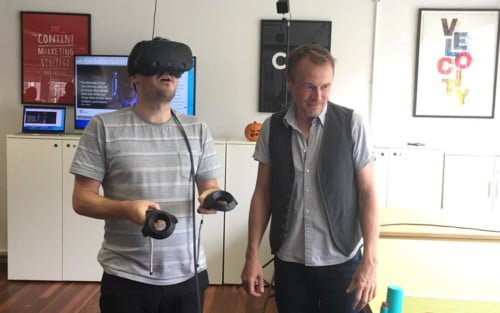“Hey, that’s not fair! The zombies sneak up behind you!”
Just another totally normal day at Velocity HQ. The kind of thing we say all the time. Nothing to see here. Move along.
Okay, not really. Let me explain.
At the Velocity away-day, one of our big themes was innovation. Why we do it, how we do it, how we get better at it. It’s something we think about a lot in our work. We’re good at doing ebooks, videos and content hubs; we’ve nailed slideshares and long-ass web pages; and we can blend ‘info’ with ‘graphics’ to great effect.
But we want to do more than that. We want to experiment, push format boundaries, try stuff out. That’s why in the last year we’ve done cool new things like write interactive quizzes, built online data calculators, and invented a whole new format that we’re super excited about. (Watch this space.)
So at the away-day, six Velocitoids got up and talked about brand new things they’d like to try out. One of those things was virtual reality.
Hence the zombies.
VR base camp
Before we go further, I should say this isn’t a definitive piece of industry thought-leadership on VR and B2B marketing. Definitive industry thought-leadership doesn’t exist yet. VR in B2B is so new it’s still wet. But the opportunities for businesses (and agencies) who get good at it and use it well are massive.
Because VR is really, really cool.
We’re at VR base camp. Starting from a position of knowing pretty much nothing about it, but really wanting to find out how we can harness the cool to do great work.
Playing around
For two days, the very lovely folks of Everywhere Brand let us borrow one of their VR set-ups and just mess around. They gave us an arcade-style zombie game where you shoot down zombie targets that creep up all around you; and a painting simulator where you design, sculpt and paint in three dimensions.
If you haven’t experienced VR (like most of our office before our try-out), there’s no way I can make this come alive for you. But it was the first time I’ve truly understood the word ‘immersive’.
In the zombie shoot ‘em up, when you slip on the headset the plastic controller in your hand turns into a rifle. It totally tricked my brain to the extent I automatically reached out to steady the non-existent barrel with my left hand, grasping nothing but air. It feels very real. The game was fun and produced a lot of laughs for onlookers as the gamer ducked, dodged and shrieked at invisible brain-eaters.
But the art simulator – Tilt Brush by Google – was where full-blown geek-out started. The designers loved it – obviously – and spent ages creating incredibly beautiful three-dimensional trees.
And even for complete cack-handers like me, it was a stunning experience. It was almost like meditation. You’re taken entirely out of your physical environment and into a blank space where a swish of your hand can create shapes, colours and glowing objects that hang in the ether only for you.
A big thing
I realise I’m at risk of writing something that, in the future (quite possibly the very near future) sounds laughably breathless because it’s become so totally commonplace. Like someone reviewing Microsoft Paint. Or Pete Tong reading out the Radio 1 web address in 1995. (Hilarious).
But VR does feel like a big thing. Something that’s going to move from niche to mainstream very quickly. And it’s not just going to be for playing games.
We don’t want to let our B2C buddies have all the fun with big, immersive experiential VR marketing. And in fact, the biggest players in B2B are already doing awesome things. GE are using Oculus Rift to give virtual reality tours of their new Deep Sea Research Centre off the coast of Brazil. Now, I only care tangentially about deep-water oil and gas extraction. I don’t read whitepapers about it for fun. But do I want to try this? You bet I do.
And there are all sorts of other things you could use VR for. I’d love to write a case study where we plunge the viewer into the world of the problem and, as they explore, they see how the solution makes things better. Ethnographic research and prototyping could be digitized to incredible effect with VR. It’s not impossible that five years from now, the mantra for building websites will be ‘VR-first’.
Still at ‘What if?’
So we’re excited by the possibilities. That doesn’t mean our first VR project is right around the corner. The tech needs to be democratized to the point where we can build using it – and where there’s a large enough audience to see what we’ve done.
But that doesn’t mean we’re going to stop playing with it or stop thinking about how we want to use it. In fact, we’ve just booked tickets to the Virtual Reality Show in April.
If you haven’t tried out VR yet, maybe see you there. We’d definitely recommend playing with it. And if you want to be an industry leader in the next big thing, it’s something that needs to be on your to-do list now.

